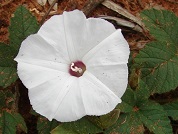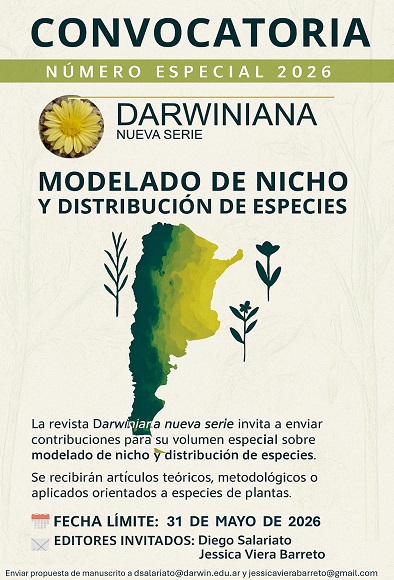Una nueva especie endémica de Distimake (Convolvulaceae) para la flora de Misiones, Argentina
DOI:
https://doi.org/10.14522/darwiniana.2025.132.1299Palabras clave:
Distimake, flora argentina, Misiones, taxonomíaResumen
Se describe e ilustra una nueva especie endémica de Distimake que crece en Teyú Cuaré (San Ignacio, Misiones, Argentina). Estudios morfológicos de las poblaciones en su hábitat y de material de herbario depositado en CTES y SI, en combinación con análisis filogenéticos moleculares utilizando la metodología de Máxima Parsimonia e Inferencia Bayesiana, evidencian que se trata de una nueva especie para la ciencia, Distimake tenondensis. Según el análisis sobre su estado de conservación aquí propuesto, la especie se clasifica en Peligro Crítico. Por último, se proporcionan un mapa de distribución de la nueva especie descrita y una clave dicotómica para diferenciarla de las restantes especies de Distimake registradas para la Argentina.
Citas
Bachman, S.; J. Moat, A. W. Hill, J. de la Torre & B. Scott. 2011. Supporting Red List threat assessments with GeoCAT: geospatial conservation assessment tool. ZooKeys 150: 117-126. https://doi.org/10.3897/zookeys.150.2109
Biganzoli, F. & M. E. Múlgura. 2004. Inventario Florístico del Parque Provincial Teyú Cuaré y alrededores (Misiones, Argentina). Darwiniana 42(1-4): 1-24. https://doi.org/10.14522/darwiniana.2014.421-4.150
Chébez, J. C. 1996. Misiones Ñú. Campos Misioneros, algo más que el confín de la selva. Nuestras Aves 19(34): 4-16.
Chiarini, F. E. & L. Ariza Espinar. 2006. Convolvulaceae. Flora Fanerogámica Argentina 96: 1-81.
Chiarini, F. E. & A. M. Anton. 2019. Distimake, en F. O. Zuloaga & M. J. Belgrano (eds.), Flora Argentina 20(2): 317-321.
Darriba, D.; G. Taboada, R. Doallo & D. Posada. 2012. jModelTest 2: more models, new heuristics and parallel computing. Nature Methods 9: 772. https://doi.org/10.1038/nmeth.2109
Doyle, J. & J. L. Doyle. 1987. A rapid DNA isolation procedure for small quantities of fresh leaf tissue. Phytochemical Bulletin 19(1):11-15.
Drummond, A. J.; M. A. Suchard, D. Xie & A. Rambaut. 2012. Bayesian phylogenetics with BEAUti and the BEAST 1.7. Molecular Biology and Evolution 29: 1969-1973.
Ferreira, P. P. A. & S. T. S. Miotto. 2013. O gênero Merremia (Convolvulaceae) na Região Sul do Brasil. Rodriguésia 64(3): 635-646. https://doi.org/10.1590/S2175-78602013000300014
Goloboff, P.; J. Farris & K. C. Nixon. 2008. TNT, a free program for phylogenetic analysis. Cladistics 24: 774-786. https://doi.org/10.1111/j.1096-0031.2008.00217.x
Gottsberger, G. & I. Silberbauer-Gottsberger. 2006. Life in the Cerrado: A South American Tropical Seasonal Ecosystem. Vol. I: Origin, Structure, Dynamics and Plant Use. Ulm: Reta Verlag.
Hall, T. A. 1999. BioEdit: A user-friendly biological sequence alignment editor and analysis program for Windows 95/98/NT. Nucleic Acids Symposium Series 41: 95-98.
IPBES. 2018. The IPBES regional assessment report on biodiversity and ecosystem services for the Americas. Secretaría de la Plataforma Intergubernamental Científico-Normativa sobre Biodiversidad y Servicios Ecosistémicos, Bonn, Alemania.
IUCN. 2022. Guidelines for using the IUCN Red List categories and criteria, version 15.1. Prepared by the IUCN Standards and Petitions Committee. https://www.iucnredlist.org/resources/redlistguidelines
Keller, H. A. 2021. Áreas clave para Biodiversidad (KBA, Misiones): Flora Clave. Aves Argentinas 60: 10-11.
Kojima, R. K.; A. R. G. Simões & R. Simão-Bianchini. 2024. Convolvulaceae in the Serra da Canastra National Park, Minas Gerais, Brazil. Rodriguésia 75: e01632023. 2024. http://dx.doi.org/10.1590/2175-7860202475057.
Kress, W. J.; K. J. Wurdack, E. A. Zimmer, L. A. Weigt & D. H. Janzen. 2005. Use of DNA barcodes to identify flowering plants. Proceedings of the National Academy of Sciences 102(23): 8369-8374.
Nanni, A. S.; M. Piquer Rodríguez, D. Rodríguez, M. Nuñez Regueiro, M. E. Periago, S. Aguiar, S. Ballari, C. Blundo, E. Derlindati, Y. Di Blanco, A. Eljall, H. R. Grau, L. Herrera, A. Huertas Herrera, A. E. Izquierdo, J. N. Lescano, L. Macchi, F. Mazzini, M. Milkovic, L. Montti, A. Paviolo, M. Pereyra, R. Quintana, V. Quiroga, D. Renison, M. Santos Beade, A. Schaaf & N. I. Gasparri. 2020. Presiones sobre la conservación asociadas al uso de la tierra en las ecorregiones terrestres de la Argentina. Ecología Austral 30(2): 304-320. https://doi.org/10.25260/EA.20.30.2.0. 1056
Martínez Crovetto, R. 1963. Esquema fitogeográfico de la Provincia de Misiones (República Argentina). Bonplandia 1(3): 171-223. https://doi.org/10.30972/bon.
Mwanga-Mwanga, I.; M. S. M. Sosef & A. R. G. Simões. 2022. Convolvulaceae, en M. S. M. Sosef (ed.), Flore de l’Afrique Centrale. Meise: Meise Botanic Gardens.
O’Donell, C. A. 1939. Las especies argentinas del género Merremia. Lilloa 5: 35-64.
O’Donell, C. A. 1941. Revisión de las especies americanas de Merremia (Convolvulaceae). Lilloa 6: 467-554.
Petrongari, F. S.; A. R. Simões & R. Simão-Bianchini. 2018. New Combinations and Lectotypifications in Distimake Raf. (Convolvulaceae). Phytotaxa 340(3): 297-300. https://doi.org/10.11646/phytotaxa.340.
Petrongari, F. S.; R. Simão-Bianchini, S. Rokni, I. D. Man, L. W. Chatrou, V. B. Shimpale & A. R. G. Simões. 2024. Distimake (Convolvulaceae) expanded: five additional species from the Neotropics and Eastern Africa. Rheedea 34(5): 521-532.
Pisuttimarn, P.; A. R. G. Simões, F. S. Petrongari, R. Simão-Bianchini, J. C. J. Barbosa, I. D. Man, L. H. M. Fonseca, S. B. Janssens, S. B Patil, V. B. Shimpale, P. Pornpongrungrueng, F. Leliaert & L. W. Chatrou. 2023. Distimake vitifolius (Convolvulaceae): reclassification of a widespread species in view of phylogenetics and convergent pollen evolution. Botanical Journal of the Linnean Society 202(3): 363-388. https://doi.org/10.1093/botlinnean/boac077
POWO. 2025. Plants of the World Online. Kew: Royal Botanic Gardens. https://powo.science.kew.org/ (Consulta 16 Marzo 2025).
Rambaut, A. 2009. FigTreeTree. Figure Drawing Tool. Version 1.3.1. Disponible en: http://tree.bio.ed.ac.uk/software/figtree/
Rambaut, A.; M. A. Suchard, D. Xie & A. J. Drummond. 2014. Tracer v1.6. Disponible en: http://beast.bio.ed.ac.uk/Tracer
Rojas, J. L.; H. A. Keller & R. Ramirez. 2023. Impacto de Melinis minutiflora (Poaceae) en la diversidad de plantas vasculares de pastizales de las areniscas de Misiones (Argentina). Boletín de la Sociedad Argentina de Botánica 58(1): 71-80. https://dx.doi.org/10.31055/1851.2372.v58.n1.38517
Salariato, D. L.; C. A. Zanotti, & F. O. Zuloaga. 2021. Threat patterns and conservation status of endemic vascular flora in Argentina: A quantitative perspective. Phytotaxa 520: 21-39. https://doi.org/10.11646/phytotaxa.520.1.2
Simões, A. R.; A. Culham & M. Carine. 2015. Resolving the unresolved tribe: a molecular phylogenetic framework for Merremieae (Convolvulaceae). Botanical Journal of the Linnean Society 179: 374-387. https://doi.org/10.1111/boj.12339
Simões, A. R. & G. Staples. 2017. Dissolution of Convolvulaceae tribe Merremieae and a new classification of the constituent genera. Botanical Journal of the Linnean Society 183(4): 561-586. https://doi.org/10.1093/botlinnean/box007
Simões, A. R & S. More. 2018. Synopsis and lectotypification of Distimake rhyncorhiza (Dalzell) Simões & Staples (Convolvulaceae): a little known species from the Western Ghats (India). Phytotaxa 336: 293-298. https://doi.org/10.11646/ phytotaxa.336.3.8
Simões, A. R; P. Pisuttimarn & L. W. Chatrou. 2020. New combinations in Decalobanthus (Convolvulaceae). Kew Bulletin 75: 55.https://doi.org/10.1007/S12225-020-09907-2
Simões A. R.; G. Huerta-Ramos, A. L. C. Moreira, J. R. L. Paz, J. Grande Allende, P. Pisuttimarn, P. Rattanakrajang, J. C. J. Barbosa, R. Simão-Bianchini, R. K. Kojima, C. P. Paixão, M. Declercq, S. P. Kagame, J. A. Luna, M. R. Pace, C. Alcantara, B. D. Williams, L. O. Duque, V. Gowda, V. B. Shimpale & L. Eserman. 2024. Sweet potato, morning glories, bindweeds: an overview of Convolvulaceae. Rheedea 34(5): 267-308.
Taberlet, P.; L. Gielly, G. Pautou & J. Bouvet. 1991. Universal primers for amplification of three non-coding regions of chloroplast DNA. Plant Molecular Biology 17(5): 1105-1109.
Tamboli, A. S.; J. V. Dalavi, S. K. Kadam, S. R. Yadav, S. P. Govindwar, & A. R. Simões. 2021. New molecular phylogenetic evidence for Indian endemic species of the tribe Merremieae, Convolvulaceae. Plant Biosystems 156: 440-449. https://doi.org/10.1080/11263504.2021.1881642.
Thiers, B. [permanentemente actualizado, consulta 2025] Index Herbariorum: a global directory of public herbaria and associated staff. New York Botanical Garden’s Virtual Herbarium. http://sweetgum.nybg.org/ih
Velazco, S. J. E.; H. A. Keller & F. Galvão. 2018. Pequeños pero importantes: las comunidades de vegetales leñosos de los afloramientos de arenisca de Teyú Cuaré (Misiones, Argentina). Boletín de la Sociedad Argentina de Botánica 53(3): 421-433. https://doi.org/10.31055/1851.2372.v53.n3.21315
White, T. J.; T. Bruns, S. Lee & J. Taylor. 1990. Amplification and direct sequencing of fungal ribosomal RNA genes for phylogenetics. PCR Protocols: A Guide to Methods and Applications 18(1): 315-322.
WWF. 2024. Save the Cerrado: Our Climate Depends on It. World Wildlife Fund.
Zanotti, C. A.; H. A. Keller & F. O. Zuloaga. 2020. Biodiversidad de la flora vascular de la provincia de Misiones, Región Paranaense, Argentina. Darwiniana, nueva serie 8(1): 42-291. https://doi.org/10.14522/darwiniana.2020.81.878
Zuloaga, F. O.; C. A. Zanotti & D. L. Salariato. 2025. Actualización del Catálogo de las Plantas Vasculares del Cono Sur II. Darwiniana, nueva serie 13(1): 189-244. https://doi.org/10.14522/darwiniana.2025.131.1301

Descargas
Publicado
Cómo citar
Número
Sección
Licencia

A partir de 2012, esta obra está licenciada bajo una Licencia Creative Commons Atribución-NoComercial 2.5 Argentina .
Cualquier obra derivada deberá estar previamente autorizada con nota escrita de los editores.







